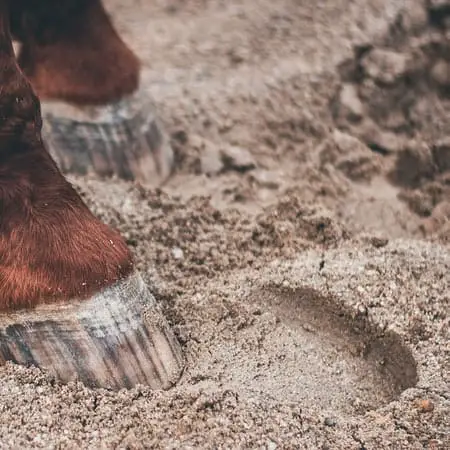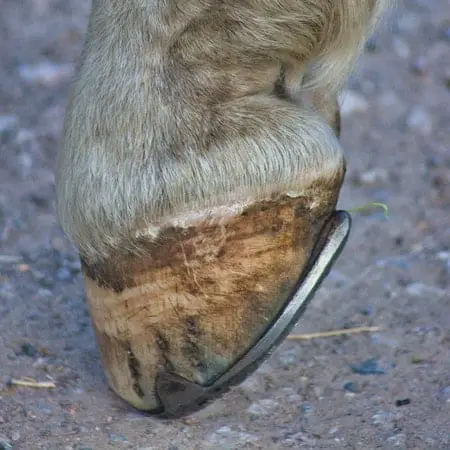Navicular disease is a condition in the horse’s foot that causes pain and lameness. Horses with navicular typically have difficulty walking, especially when they need to walk on hard surfaces or go up and down hills. Navicular disease can be diagnosed by physical examination of the hoof, radiographs (x-rays), blood tests for inflammation, and nerve conduction studies. There are many treatments for navicular disease such as anti-inflammatory medications, shockwave therapy for acute cases, cortisone injections into affected joints for chronic cases, corrective shoeing if necessary and surgery.
So can you ride a horse with navicular? The answer is yes! If your horse has been diagnosed with this condition and as long as the horse has no pain or lameness in the front legs, then they can be ridden. However, if there are signs of pain in the front leg(s), then it’s best not to ride them until their condition improves.
What is Navicular in Horses
Navicular syndrome is a condition that has caused negative connotations and fear for decades, but thanks to increasing veterinary discoveries and studies it may not always be the case anymore. Every situation is unique, every horse different; there are some circumstances where navicular can still be maintained at healthy levels without having any career-ending effect on your beloved animal.

Every situation is unique for every horse ever person will experience different symptoms based on many factors such as age or breed type.
Some things have been proven successful in treatment including: drainage procedures that removes fluid build-up around sensitive tissue near navicular bone. Surgery which stabilizes painful joints by cutting away damaged cartilage so there are less pressure points when walking. New techniques like laser therapy has also shown promising results.
Navicular is a difficult injury to treat but can be managed if the situation seems manageable. The horse may live and even ride for years after diagnosis with proper maintenance, so long as they are not put in situations where their condition will worsen or cause additional harm.
Can you Cure Navicular in Horses?
Navicular is an incurable foot condition, but it can be treated and maintained. In order to assess the severity of your horse’s lameness or whether Navicular may have caused his lameness at all, a soundness exam should be performed by a veterinarian.
The vet will examine different parts of your horse’s body including its muscular structure for strength and tone as well as various joints in search for pain response when pressure is applied.
They also check their feet to make sure that nothing unusual has occurred like infections from injuries which could cause excessive inflammation within them causing laminitis (inflammation without infection).
Diagnosis of Navicular in Horses
Horses with navicular pain will be sensitive to hooftesters, flexion of the lower limb, and/or the reverse wedge test. Most horses however are negative to these tests. That leaves response to diagnostic nerve blocks and diagnostic joint blocks as the most reliable diagnostics for this condition.
Diagnostic nerve block consist of infusing mepivacaine around palmar digital nerves when a horse is sound in order assess whether or not there’s a problem on that side; if they’re lame while it’s numb then we know where their issue is coming from (usually back half).

Radiographs are an important diagnostic tool in identifying the source of pain to help with treatment. Despite this, radiograph results can be misleading since they miss many soft tissue parts and abnormalities may not show up on them anyways. Due to these factors, horse owners should take caution before assuming a sound animal is suffering from Navicular Syndrome just because it doesn’t have any signs or symptoms yet – even if their x-rays look abnormal!
Riding a Horse with Navicular
Riding a horse with navicular can have serious consequences. Consult your vet if you’re considering it! Consultations take into account lots of different factors that go along with riding a horse on Navicular disease such as what type of terrain will be ridden over, how tall jumps may be jumped and trotted through.
Navicular horses are notoriously difficult to treat. But, if you’re a horse owner who has navigated the challenges of Navicular before and still needs help with your current case, here is what I recommend:
First off- it depends on how advanced your horse’s condition currently is as well as other factors such as its weight or arthritis status. If all treatments have been tried but there was minimal response then consult with an equine vet in order to give them input for next steps (treatment options).

Navicular horses can’t be ridden at the early stage, but if your horse’s Navicular isn’t too far along and it is helped by treatments then there may be a chance to ride him. It all depends on the circumstances of course; you’ll have to ask for permission from his vet before going ahead with any riding activities.
If that green light is granted though – which are pretty rare cases-then he will likely come with some conditions regarding how much time or what type of work they allow their patients to do when being ridden as well as restrictions about where such rides take place (mostly indoors).
The doctor might say no jumping at first, maybe 20 minutes walking through trotting per day only… And these limitations should be adhered to for the safety of your horse.
Horses are a lot like humans in the sense that they need to communicate with you. The horse’s body language can inform us of many things, one being their level of exhaustion and capability. If your horse is showing signs such as tiredness or lack thereof for riding, it might be time to have them re-evaluated by a vet so we may get back them back on track!
Final Thoughts
There are a few ways to help your Navicular horse relieve their pain and keep them comfortable. You should always talk with your vet before deciding if you want to ride or work, but these things can make it easier for both of you.
Navicular horses are often not able to be ridden. But, there is a chance that they can if their vet approves the activity and helps them in other ways as well!

